Guest blog by Wendy Rhiner
So you have heard a great deal lately about native plants. Maybe you have seen an announcement on Facebook about a plant sale, or maybe the local newspaper ran an article about a gardener in your area who works only with native plants. In any case, you want to explore the possibility of adding some Louisiana native plants to your garden. You just do not know where to begin or what to plant or even why.
The why is fairly easy to answer. Native plants have grown in popularity recently with gardeners who want to help restore the natural landscape of Louisiana before the age of European settlement. While doing just that, gardeners are helping pollinators and other insects that face great threats by habitat loss, pesticides, and other man-made problems. Consequently, the insects come back, and secondarily, the birds return because of the insects. Essentially, gardeners who work in native plants wish to restore the ecological balance and natural heritage of Louisiana. Frankly, too many of our yards are ecological wastelands for wildlife, offering birds, butterflies and other wildlife very little, but we have the power to change that.
Additionally, native plants require less fuss! If the plants you choose match your soil, sunlight and water conditions, you will have to weed less, you will not have to use pesticides (for you are planting natives to attract insects!), and watering can indeed be reduced, dependent on the species planted. And what is most attractive to me about native plants? In the February freeze most of us experienced this year, my natives and those of my friends survived! Natives are built to handle our climate and its conditions!
But where to find these nature-restoring, insect-attracting, pollinator-important plants? And which species should you choose? I offer here some simple advice on easily obtained and easy-to-maintain native plant species. I am no expert, to be sure, so what follows is only meant to wet your whistle!
WHERE TO GO
Baton Rouge
If you are in the Baton Rouge area, Hilltop Arboretum often carries a good variety of native plants at its nursery. Not only can you buy plants, but you can also visit the restored prairie, featuring Louisiana native plants. Clegg’s Nursery and its various satellite sites often sell natives. In fact, in the past, the Siegen Lane site has hosted a “Tree Spree” in the fall, offering a wide selection of native trees for fall planting.
New Orleans
In New Orleans, you have a few options: Delta Flora Nursery stocks a wide variety of natives for both the wet areas in your yard and the standard flower bed. They also carry native trees and bushes. Next, Pelican Greenhouse (in New Orleans City Park) has plant sales every weekend, Friday – Sunday, from 9:00-12:00 p.m. Pelican also offers native trees, bushes and many plants. Finally, Barber Laboratories in Harahan, sells many species that attract butterflies. The establishment is run by Louisiana’s official Bug Lady Linda Auld.
Shreveport
In the Shreveport area, the Louisiana Nursery (in Keithville, LA) stocks a few natives along with what is referred to as “nativars,” native plants that have had their genetic material altered to produce bigger blooms or flowers that bloom longer, color variety, or even height variations. Nativars remain the subject of often-heated debate, but many of these plants retain the pollen or nectar that appeals to insects. The Caroline Dorman Nature Preserve (in Saline, LA) hosts plant sales of the natives seen at the preserve itself.
Lafayette
If you live in the Lafayette area, the first place you need to look is the Acadiana Native Plant Project. Not only does Acadiana Native Plant Project have periodic plant sales, but it also offers great volunteer opportunities and seed swaps. Another source is Urban Naturalist. Urban Naturalist also sells organic compost and pine straw, which is one of the best mulches to use because it adds the acidic content to soils that some native plants require.
Online
An online source of natives has been a godsend for me; Almost Eden Plants offers a wide range of natives and nativars for purchase. Almost Eden does not have a retail nursery, but it does offer curbside pick-up if you live in the Merryville area. Otherwise, plants are shipped expeditiously to your home.
WHAT TO GET
So you have a few places to visit. But what should you buy? The answer always depends on the growing conditions in your yard: soil, sunlight, water. These need to be determined before you buy any plant. What type of soil do you have – clay, sandy, loam? You can do a soil test the LSU Ag Center kit which is available at many nurseries. Secondly, how much sunlight will your garden bed get – full (6-8 hours), part sun (3-4 hours), dappled shade, etc.? You will also want to determine if there are low spots in your yard that are prone to flooding or ponding. There are native species that love those conditions!
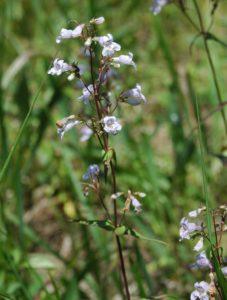

Now, that you are looking, let’s start with some of the easiest plants to grow and maintain. One of my favorites is the Gulf Coast Penstemon (Brazos penstemon). It blooms all year round in my Metairie yard, and bees and hummingbirds love it. I find that it does quite well in my clayey soils. It can grow 2-3 feet if it loves where it is growing. This plant is easily obtained at plant sales and nurseries like Delta Flora.
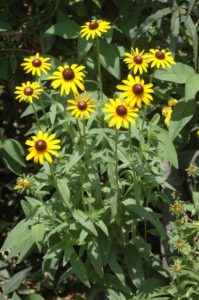
 Another easy to obtain and easy to grow plant is the Brown-eyed Susan (Rudbeckia triloba). This native will even take a bit of shade! Blooming all summer, triloba’s dead blooms in the fall provide seeds for birds.
Another easy to obtain and easy to grow plant is the Brown-eyed Susan (Rudbeckia triloba). This native will even take a bit of shade! Blooming all summer, triloba’s dead blooms in the fall provide seeds for birds.
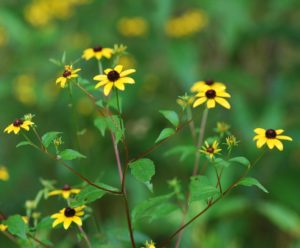
 Another Rudbeckia easy to find and maintain is Black-eyed Susan (Rudbeckia hirta). This sunny summer native provides nectar for hungry bees, and like its cousin, Rudbeckia triloba, hirta provides seeds for birds in the fall.
Another Rudbeckia easy to find and maintain is Black-eyed Susan (Rudbeckia hirta). This sunny summer native provides nectar for hungry bees, and like its cousin, Rudbeckia triloba, hirta provides seeds for birds in the fall.
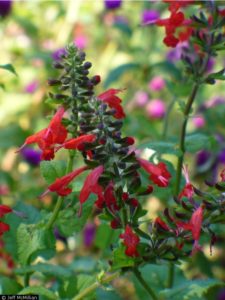
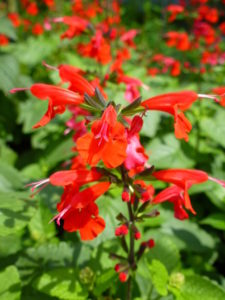 Hummingbirds love the Tropical Sage (Salvia coccinea) that looms in my yard nearly year-round. This plant, though native to Texas, does quite well in average garden soil and can even tolerate some shade. It can get leggy, so trimming is essential. But do not worry; it grows quickly! This sage is perhaps one of the easiest natives to obtain.
Hummingbirds love the Tropical Sage (Salvia coccinea) that looms in my yard nearly year-round. This plant, though native to Texas, does quite well in average garden soil and can even tolerate some shade. It can get leggy, so trimming is essential. But do not worry; it grows quickly! This sage is perhaps one of the easiest natives to obtain.
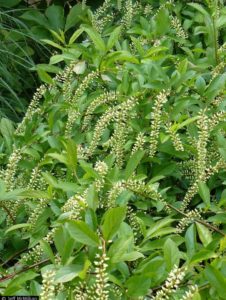
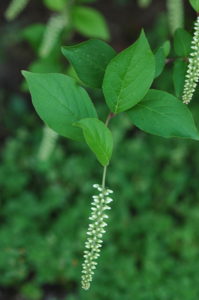 Do you wish to make a bigger investment? Go for native bushes! One of my favorite bushes that is no muss-no fuss is Virginia Sweetspire (Itea virginica). This deciduous shrub can make it to 6-8 feet, and its blooms of white, drooping spires attract nectar-seeking insects. Sweetspire can also help with erosion control and can even take very wet soils, making it a good stablizing plant in wet yards.
Do you wish to make a bigger investment? Go for native bushes! One of my favorite bushes that is no muss-no fuss is Virginia Sweetspire (Itea virginica). This deciduous shrub can make it to 6-8 feet, and its blooms of white, drooping spires attract nectar-seeking insects. Sweetspire can also help with erosion control and can even take very wet soils, making it a good stablizing plant in wet yards.
Any of the native Mallows grown in our area are excellent for moist backyards. Many native Mallows prefer moist soils and full sun, often hard conditions to work with. But the Halberd-leaf Mallow (Hibiscus laevis) likes it moist and sunny, as do the Crimson-eyed Mallow (Hibiscus moscheutos) and the Texas Star Mallow (Hibiscus coccineus). Hummingbirds have visited my mallows, though I cannot say whether they prefer them. These plants are also deciduous.
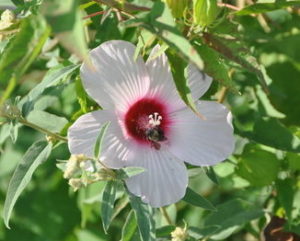
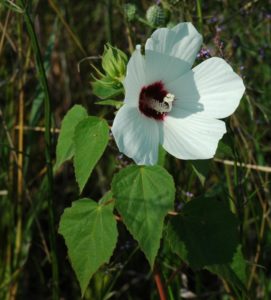

If you have an ugly fence or wall to cover, why not plant native vines that attract hummingbirds? Coral Honeysuckle (Lonicera sempervirens) is an excellent substitute for non-native honeysuckles, and its wildlife impact cannot be overstated. Crossvine (Bignonia capreolata) is another excellent choice.
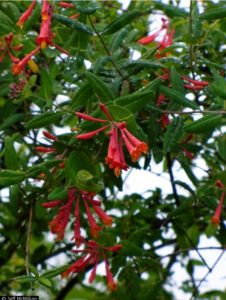
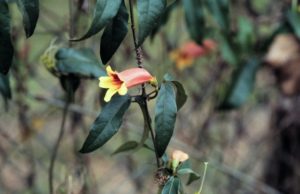
You can also check your local native plant society to learn more about native plants for your specific region. There are also many good websites that will help you in choosing your species. Some to check out include:
- https://www.nwf.org/nativeplantfinder/
- https://www.audubon.org/native-plants
- https://www.fs.fed.us/wildflowers/Native_Plant_Materials/Native_Gardening/index.shtml
Don’t be afraid to experiment! That is part of the fun! But more important, do not hesitate to lend your voice to nurseries, policy makers, city planners in support of adding more natives to the landscape. Entomologist and native plant expert Doug Tallamy suggests that we consider making our own backyards national parks for wildlife. I took Tallamy’s advice, and I am ever grateful!
Resources:
- LSU Hilltop Arboretum (11855 Highland Rd, Baton Rouge)
- Clegg’s Nursery (four locations in Baton Rouge and Denham Springs)
- Delta Flora Nursery (2710 Touro St, New Orleans)
- Pelican Greenhouse (2 Celebration Dr, New Orleans)
- Barber Laboratories (6444 Jefferson Hwy, Harahan)
- Louisiana Nursery (12290 Mansfield Rd, Keithville)
- Caroline Dorman Nature Preserve (216 Caroline Dorman Way, Saline)
- Acadiana Native Plant Project
- Urban Naturalist (216 Madison St, Lafayette)
- Almost Eden


